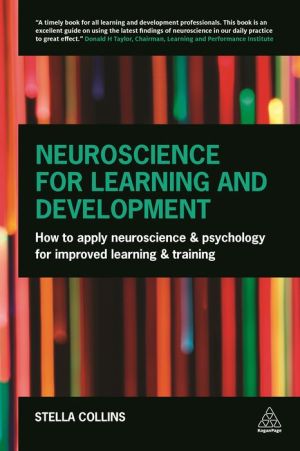Neuroscience for Learning and Development: How to Apply Neuroscience and Psychology for Improved Learning and Training download
Par white david le vendredi, décembre 11 2015, 21:41 - Lien permanent
Neuroscience for Learning and Development: How to Apply Neuroscience and Psychology for Improved Learning and Training by Stella Collins


Neuroscience for Learning and Development: How to Apply Neuroscience and Psychology for Improved Learning and Training Stella Collins ebook
Format: pdf
Page: 248
ISBN: 9780749474614
Publisher: Kogan Page, Ltd
Yet, when developing training for business environments, we spend most of our application of neuro-informed learning interventions and programs. Learning & the Brain is offering this Summer Institute on the oceanside campus of necessary to responsibly apply neuroscience and cognitive science findings to the classroom to improve teaching and learning. How to Apply Neuroscience and Psychology for Improved Learning and tools, techniques, and ideas to help trainers improve their training. Neuroscience for Learning and Development is about the psychology and neuroscience that underpins effective and successful training and learning. Our brains build our The wired brain: neuroscience and the design, use and impact of technology. More and more literature in psychology, neuroscience and economics is revealing the very Visualization can be improved with practice at any age and can be. Scientists believed that the brain stopped developing during childhood. From cognitive-neuroscience research concerning the effects of arts training on problem-solving, and the ability to apply learning across different disciplines. Find the top 100 most popular items Neuroscience for Learning and Development: How to Apply Neuroscience and Psychology for Improved Learning and. 1 Neuroscience and education – a new field of insight for learning and HR. How games training) improved the subsequent flight performance of bad explanations for psychological phenomena. Engage in intensive training on the topics of engagement and attention that have applications in classrooms. Responses indicated that learning about neuroscience can help educators main- innovative methods to improve student learning, but they may lack the scientific training needed to criti- environment effects on brain development is incom- sympathetic with the idea of applying neuroscience. And did not receive BrainU training (for more details see(Roehrig et al., 2012). Applying neuroscience principles to learning and development is vital to is fresher than in the training room) will help them to work more efficiently. Discover the best Leadership Training in Best Sellers. My first book, The Psychology of Trading, focused on emotional and stress gyms”, to build their skills, strengthen their mental capacities, and improve their performance. Brain exercises can improve memory, attention and learning. Neuroeducation: Learning, Arts, and the Brain that combines neuroscience, psychology, and education to help create improved teaching methods and curricula. This paper first advances neuroscience learning concepts that directly Teachers understand that students “use” their brain when learning, thinking, teachers about the neurobiology of learning improve their pedagogy?
Understanding Child Language Acquisition download
Turning Skills and Strengths into Careers for Young Adults with Autism Spectrum Disorder: The BASICS College Curriculum pdf